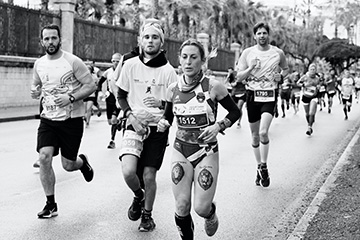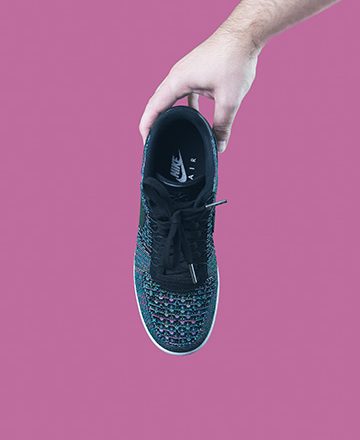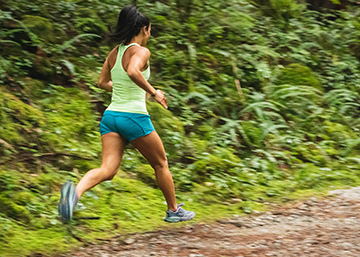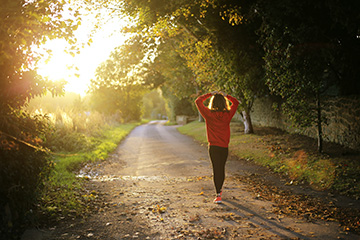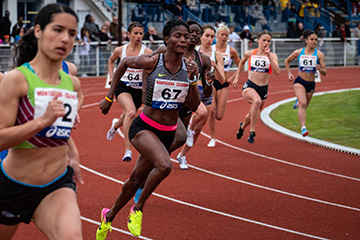By Marc Bloom
Sonja Friend-Uhl, who has won 22 national masters’ championships in road, track and cross-country since turning 40 in 2011, has no problem running fast. She just has to find the time to do it.
Friend-Uhl celebrated her 44th birthday in March on the weekend of the 2015 USATF Masters Indoor Championships in Winston-Salem, North Carolina. Friend-Uhl, who lives in Brentwood, Tennessee, outside Nashville, with her husband and two daughters, swept the women’s 40-44 800, mile and 3,000 meters. In the 3k, Friend-Uhl triumphed by 55 seconds in 9:50.37 to set an American masters indoor 40-44 record.
Friend-Uhl, who won the World Masters Championships 40-44 800 and 1500 when the meet was held in Sacramento, California, in the summer of 2011, set a world masters 40-44 indoor mile record of 4:44.81 in 2012 and an American masters outdoor 1500 record, 4:16.99, that same year.
While Friend-Uhl has risen to prominence as a middle-distance specialist on the track, half of her national masters’ titles have come on the road and in cross-country, in distances ranging from the 5k to the half-marathon. She has also run two marathons, both in Florida where she used to live, with a 2:49 PR. “I prefer the intensity of the track,” she says.
Seeking intensity wherever she could find it, Friend-Uhl traveled to Japan in 1992 for the Lifesaving World Championships. She won the 2k Beach Run and was named World Champion in the event. She won it again in 1998, this time in New Zealand. That gives Friend-Uhl major titles on four running surfaces: track, road, turf and sand—surf and turf, if you will.
A hallmark of Friend-Uhl’s repertoire is her speed. As recently as last year, at 43, she ran the 800 in 2:10.79.and split 61.12 on a 4 x 400 relay. The U.S. 40-44 record is 2:07.57, by Alisa Harvey, who did it at 41. In early June, at the Music City Distance Festival in Nashville, Friend-Uhl planned to go after Harvey’s 40-44 outdoor mile record of 4:46.29.
Friend-Uhl has been racing non-stop for close to 30 years. She was a state champion in high school in Delaware, a collegiate star at William & Mary and, as a professional, a member of six U.S. national teams competing abroad. For the most part, they were far-flung events, like “Ekiden” relays in China, Japan and Korea. Another was the first IAAF world road racing championship, a 20k in Hungary, in 2006.
On one of her Ekiden trips, to Beijing, in 2005, Friend-Uhl and her American teammates went out for a run on the morning of their flight home. They got lost and wound up in a remote town, where shocked villagers berated them with threatening gestures. The chastened U.S. women dropped their pace to 6 minutes a mile making a getaway. With Friend-Uhl’s direction as the elder of the team–“My motherly instincts kicked in,” she said–the athletes found their way back safely, but not before finishing with an extended 14-miler. They all made it to the airport on time.
That flair under duress was a taste of Friend-Uhl’s typical balancing act. In addition to her daily workouts, and parenting two daughters, she puts in 20 to 25 hours a week as Physical Wellness Director of Cool Springs MD, a Nashville area wellness center, and travels the country as a Lead Trainer for Star Tracks, a fitness equipment manufacturer based in Vancouver, Washington. In addition, Friend-Uhl, who competes for the Atlanta Track Club, does private coaching for select on-line clients, while coaching a number of runners in person as well. She’s also a volunteer assistant at Vanderbilt University, mentoring the women’s track and cross-country runners.
“I’ve always had tremendous drive,” Friend-Uhl said as she prepared to get her outdoor track season rolling. Even in high school–I was in the band, choir and student government. I ran track, played basketball.”
Nowadays, while every second counts for Friend-Uhl on the track, every minute counts in her day or week. In March, she achieved her masters’ indoor track triple while suffering with a sinus infection. “I know I have to be careful not to drive myself into the ground,” she says. “But I feel most ‘alive’ when I’m pushing myself.”
It’s no wonder that at times Sonja and her husband, Brad Uhl, who works for the Department of Justice, have to call in emergency reinforcements–Sonja’s mom from Florida or Brad’s mom from Pennsylvania–to help with daughters Brianna, 13, and Alexa, 6.
Friend-Uhl—part Polish, Irish and Native American–has an array of certification degrees in health, fitness and nutrition. She never misses an opportunity to multi-task. On a trip to Atlanta for Brianna’s volleyball tournament, Sonja scooted over to Georgia Tech for a track workout: 3 sets of 1 mile and 400 with a lap jog recovery between each run. She averaged 5:35 in the miles and 66 seconds in the 400s.
In 2000, at 29, Friend-Uhl had her best year. She achieved her lifetime PRs of 2:06.4 in the 800 and 4:13.9 in the 1500. With her 4:16.99 1500 in 2012, Friend-Uhl has only slowed 3 seconds in 12 years, from 29 to 41. How many top milers, male or female, could equal that record of “agelessness”?
Friend-Uhl recognizes that, reaching her mid-40s, she walks a fine line between ambition and reality. After outstanding 2011 and 2012 seasons, she lost valuable time in 2013 to recurrent injury. “I can be my own worst enemy,” says Friend-Uhl, who trains 45 to 50 miles a week. “Not just in workouts but in going overboard in races and losing my focus.”
To help control her zeal, and get relief from the pressures of designing her own program, Friend-Uhl this year enlisted the services of former pros Andrew and Amy Begley, the Atlanta Track Club coaches. The Begleys have already been a big help, says Friend-Uhl. Early in the spring, while still recovering from her illness, Sonja was itching to hop a plane to California for the Carlsbad 5,000. Andy talked her out of it.
This summer, in addition to competing in the USA masters outdoor nationals in Jacksonville, Florida, Friend-Uhl was hoping to run the women’s masters 3,000-meter “exhibition” at the USA Nationals, June 25 to 28, in Eugene, Oregon. She’ll be aiming for the American 40-44 record of 9:27.45 set by Carmen Troncoso in 2000.
“I really appreciate the masters,” says Friend-Uhl. “We celebrate what we do and embrace one another. By pushing me, my opponents help me discover a better version of myself.” #
TRAINING LOG
Leading up to USA Masters Nationals Indoor Track & Field Championships, Winston-Salem, North Carolina, March 20-22, in which Friend-Uhl won the women’s 40-44 800 meters, mile and 3,000 meters, setting U.S. 40-44 indoor 3k record of 9:50.37.
Week Starting March 9, 2015
Monday
8 miles easy plus strength/core circuit
Tuesday
5 miles easy plus 5 x 100m strides
Wednesday
2-mile warm-up; 3 sets of 500, 300, 300, 200, 200 with 600 jog recovery between sets.
Times for 500s: 85 to 88 seconds. Times for 300s: 48 to 49 seconds. Times for 200s: 30-31 seconds. 2-mile cool-down. Plus strength/core circuit.
Thursday
6 miles easy
Friday
5 miles easy plus 5 x 100m strides
Saturday
2-mile warm-up; 4 sets of 1000 in 3:07 to 3:11 with 600 jog recovery between runs; 2-mile cool-down. Plus strength/core circuit.
Sunday
Off.
Week Starting March 16, 2015
Monday
5 miles easy plus strength/core circuit
Tuesday
5 miles easy plus 5 x 100m strides
Wednesday
2-mile warm-up; 6 x 300 in 55 to 56 seconds and 6 x 100; 3 x strides; 1-mile cool-down. Plus strength/core circuit.
Thursday
3 miles easy plus 5 x 100m strides
Friday
USA masters indoor 3,000 meters, 1st place 40-44, U.S. record, 9:50.37
Saturday
USA masters indoor mile, 1st place 40-44, 5:03.06
Sunday
USA masters indoor 800 meters, 1st place, 40-44, 2:17.42
 Nutrition tips for runners can be broad enough to include all types of runners from the casual runner to the marathon runner. That’s because good nutrition is universal. However, some nutritional information or specific food or eating suggestions are just for the marathon runner to help him or her overcome the fatigue that can occur near the end of the race, when the glycogen stored in the muscles become depleted. Good training that includes pacing helps, but you also need good nutrition to have your body in peak condition.
Nutrition tips for runners can be broad enough to include all types of runners from the casual runner to the marathon runner. That’s because good nutrition is universal. However, some nutritional information or specific food or eating suggestions are just for the marathon runner to help him or her overcome the fatigue that can occur near the end of the race, when the glycogen stored in the muscles become depleted. Good training that includes pacing helps, but you also need good nutrition to have your body in peak condition.

